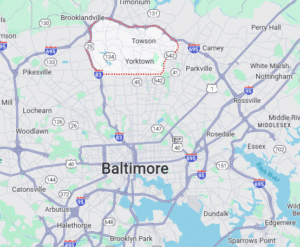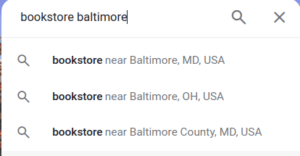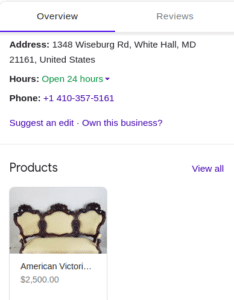What is local SEO?
Search engine optimization or SEO is the practice of improving your website’s structure and content to become more visible in the search results and grow sales. Local search engine optimization is precisely that, but specifically for local searches.
Local optimization typically includes not only standard search results in the form of links to websites but also the local pack that includes a map with a list of businesses.

Source: Google
It’s important to not just focus on keywords that have your specific location, even though these are important too. Some local searches can be done with “near me” in the search query. In some cases, Google will decide that certain search queries require local results even though the search doesn’t contain a local keyword.
The final goal of local SEO campaigns is to improve your ecommerce site’s visibility in searches done from a local area and receive either traffic to your site and Google Business Profile or improve brand awareness.
All of this means local ecommerce SEO has a bit different playing field, and the top SEO techniques that influence local search rankings are going to be different as well.
Why is local SEO important?
Local optimization is not only a valid investment for any local business owner, but it’s also a necessary digital marketing technique. Here’s why this type of SEO will be beneficial for an online store with a physical location.
- Online visibility boost. Local online presence on search engine result pages achieves two important goals. It directs local traffic to your website, and it improves brand awareness. Even if a local resident won’t visit your website, they will learn that your business is nearby.
- Better communication with existing and potential customers. Since you know an important fact about the customers who interact with your site on local searches — the fact that they’re close to your store – you can create tailored experiences for them. Local events and tailored discounts can improve engagement and lead to more sales.
- Increasing mobile traffic. Most consumers use their phones for near-me searches. 78% of retail website traffic also comes from mobile platforms, so if you increase local mobile traffic, you’re likely going to increase sales as well.
- Strong reputation management. Leaving reviews is a key element of local SEO strategies. So, as an added bonus, you’re going to improve your reputation on the internet.
Cost-effectiveness. Even though SEO requires initial investment, it can produce results in the long term with little upkeep. That’s more cost-effective than running paid advertising campaigns or traditional advertising.
How does local SEO work?
To form search engine rankings, Google and other search engines consider hundreds of factors. The most prominent ones for regular search are the keywords the page is optimized for, technical optimization of the site, first-rate SEO content, and the number of quality backlinks.
For local search, Google adds a variety of other factors. Local Google search results are formed on the basis of three main principles — relevance, prominence, and proximity.
The factor of relevance refers to how relevant the content of the page is for the keyword of the search query. For local searches, this also includes the relevance of your Google Business Profile to that keyword.
You can influence relevance by optimizing the page for the right keywords and making the content of the page helpful to the consumers.
The factor of prominence refers to how prominent your business is and whether it’s trustworthy. You can influence this by receiving more online reviews and getting mentions from local websites.
The last factor you can’t influence. Proximity is the measure of how close the searcher is to your business location.
These are the local SEO basics. Now, let’s see what local SEO techniques and tips you can use to optimize your site for local search.
How to optimize your ecommerce store for local SEO
There are ten major local SEO optimization strategies for ecommerce stores. Let’s go through them one by one.
Keyword research
Keyword research is perhaps the first of all types of SEO local ecommerce tasks. The most important step is to find the so-called local keyword modifiers. These are the keywords that people would add to their search query to find businesses in their area.
For instance, if you own a bookstore in Towson, Maryland, there might be plenty of local keyword modifiers users can find your business with.

Source: Google Maps
They might look for “bookstore in Towson,” but also for “bookstore in Maryland,” “bookstore in Baltimore area,” or “bookstore near Yorktown.” You can figure out what these local keywords are by using a specialized keyword research tool like Google Keyword Planner or more advanced SEO tools.
You can also check where the searchers are geographically by running your keywords through Google Trends. It can narrow down interest in keywords to metro areas and cities.

Source: Google Trends
Another way to get a bit of insight into what keywords can be used for local searches is with Google’s autocomplete. Start writing a keyword in Google Maps, and it’ll show you what alternative keywords can be used.

Source: Google Maps
One thing to keep in mind is that you don’t want to optimize your site for search engines with keywords containing “near me.” These keywords show companies that are physically close to the searcher, and including “near me” on your pages has no effect on that.
Build links from other local businesses and websites
Google measures the prominence of your business by multiple factors. One of the key factors is the quality of backlinks your ecommerce business page has.
Generally, you want to earn links from large news media websites and industry blogs. For local optimization, you’re looking at a variety of links from local websites. Here’s a complete list of websites you can get local backlinks from:
- Local news websites
- Local directories of businesses
- Local event websites
- Local business review websites
- Other local businesses
- Local bloggers
With event websites and directories, you can just create a profile on these platforms and receive a backlink. To receive a backlink from local bloggers and businesses, you’ll have to create valuable content for them or do something newsworthy. This will also get you links from local news websites.
Optimize for mobile devices
76% of consumers use phones to make purchases online, which is more than purchases made from a desktop. A lot of local searches are also made from mobile. That’s one of the reasons mobile optimization is essential in SEO.
Another important reason is that good loading speed and quality of website performance on desktop and mobile are important factors for both local and general SEO.
Mobile SEO has two main components: user experience and on-page SEO. From the standpoint of on-page SEO, you need to ensure the Core Web Vitals are optimized on both mobile and desktop. Core Web Vitals are key features of your website that boil down to how fast it loads and how correctly it displays website elements.
From the standpoint of UX, you need to follow the best practices of mobile website design. Use a responsive template that changes size and layout based on the user’s device, make pages more vertical instead of horizontal, and use larger buttons. Many website builders provide these features by default, so you won’t have to struggle with optimizing them. What you might want to do is disable most pop-ups on mobile and not play some heavy video files to improve loading speed.
Build local citations
When you’re building backlinks for a regular SEO campaign, you mainly care about getting the link in the first place and maybe attracting some traffic from the page that links to you. With local search optimization, you’re also interested in building citations alongside the links.
Citations are mentions of your business’s name, address, and phone number (NAP) on the public websites that link to you. Building local citations with a backlink and NAP from other sites improves your local search presence as it serves as a signal of trustworthiness to Google.
The main types of sites where you can get a citation are local directories. Other types include event websites and review websites.
Improve your on-page SEO strategy
On-page SEO optimization isn’t very different for local search, but it’s important to mention that you have to work on it too, to have a chance of ranking for local keywords. You should focus on these key areas:
- Creating unique, descriptive, and keyword-rich SEO tags — meta title, meta description, H1s, and alt texts for images.
- Clustering keywords to specific pages and using them in heading tags and throughout the text.
- Linking between pages and prioritizing the pages you need to rank the most to receive more internal links.
- Ensuring page speed and other Core Web Vitals are optimized.
If you’re unsure where to start, start with running a website audit. It can highlight the most pressing problems with on-page SEO that you can prioritize.
Maximizing Location Pages For Online Ordering
In local search results, your Google Business Profile listing in the local pack results is as important as the link to your site in regular search engine results. You should use that internet real estate to move users towards making a purchase on your site.
The most straightforward thing you should do is add a link to it so users can go directly from the business listing to your website. You could also add products to the listing to let users browse your best products from Google Maps results and go directly to the product they want to buy.

Source: Google Maps
Make sure to add local delivery options and make the whole process of finding and purchasing from your ecommerce website as easy as possible.
Add schema markup to your website
Schema markup is a form of structured data that can communicate facts about your local ecommerce business to Google. These facts can be displayed in local SERP, so it’s an important optimization factor.
With schema markup, you can display information about your business in SERP such as opening hours, location, reviews, as well as images and pricing for product pages.

Source: Google
Schema markup is added in the form of structured data. You can generate this code with Google’s Structured Data Markup Helper, or you might generate it with an AI tool like ChatGPT.
Claim your Google Business Profile listing
If you don’t have a Google Business Profile, you’re missing out on half of the opportunities for optimization. Claim the GBP of your business if it already exists, or create one. Here’s a brief local SEO checklist for optimizing it:
- Choose the right category for your business to appear in category searches on Google Maps.
- Upload high-quality images of your business and encourage customers to tag you in photos.
- Add basic business information like NAP and opening hours.
- Add a backlink to your business.
- Create a Q&A section.
- Add products to the profile.
- Encourage reviews and respond to them frequently.
Encourage reviews
The last point is especially important for ranking your GBP listing. Having a lot of positive reviews isn’t the only ranking factor, but in many cases, the listings that rank the highest have more positive reviews. Having positive reviews on Google, Facebook, and other review platforms also works as a strong social signal that can help with improving click-through rates and conversions.
To encourage reviews, you can reach customers via SMS, newsletter, or other channels of communication and simply ask them to share their experiences on Google. You can make this campaign more effective by personalizing the request for reviews.
Ask people who have recently made a purchase or leads that are likely to be brand promoters, and you’ll have a higher likelihood of them acting on it.
Ensure NAP consistency
Since Google uses mentions of your business on the internet to verify its authenticity, you need to make sure that mentions of the basic information about your business are uniform across the web.
This means double-checking that your GBP listing and profiles on the local directory and review websites don’t have typos in name, address, and phone number. Also, ensure that punctuation or abbreviations are the same on all platforms and change the NAP everywhere if you have to change, say, your phone number.
A single typo probably won’t amount to a significant drop in local search rankings, but if NAP mentions are inconsistent, you might run into problems.
Top local SEO tools
No organic SEO project is possible without proper tools to measure success and fix errors. The same is true about local SEO. Here are the seven tools that should be in your arsenal.
SE Ranking’s local keyword rank tracker
Many important metrics in SEO can’t be seen with Google’s native set of tools. Google can show you core metrics like organic traffic and the number of new users, but it’s more convenient to track more advanced metrics with specialized SEO tools.
One of the tools like these is SE Ranking. This platform has multiple features that are handy in SEO, from a backlink checker to a website audit. The tool that is relevant for this case is the local keyword rank tracker. It can track your website’s positions for keywords in general and for specific locales. You can choose a city or a zip code to monitor positions. You can also track which keywords give you local pack results and how you rank in map searches.
Tracking your site’s positions for all keywords helps you understand how well-optimized each page is, see changes that result from your SEO efforts, and judge overall campaign success. It’s possible to keep tabs on keyword rankings of competition as well and see your top competitors in local search.
BrightLocal
BrightLocal is another company that offers local SEO services that focus on creating and managing citations and reviews.
This platform can do the heavy lifting in building citations for you. All you have to do is pick the platforms from the list. It will then monitor citations to ensure none disappear.
Another part of the platform that helps you run great local SEO campaigns is the reputation management features. With BrightLocal, you can upload lists of your clients and their contact data and use it to review campaigns via email or SMS.
Google Business Profile
Your Google Business Profile is the only tool from this list that you absolutely must have in your arsenal. GBP listings are the basis of Google Maps search, and they can be used to convert users into buyers.
That’s why you should keep your GBP filled with useful information, updated, and respond to customer feedback quickly.
Uberall Store Locator
Uberall is a local online marketing management tool. It can help you automate responses to reviews and improve engagement on your GBP profile.
The feature that many ecommerce local businesses can benefit from is the store locator. It’s a page you can host on your website that helps users find your nearest store.
Vendasta
Vendasta offers a set of agency tools that range from CRM to workflow automation tools.
The tools that Vendasta offers for local optimization cover mostly business listings management. You can also run an audit that shows your business’s local optimization score across several points like reviews and listing visibility in search. It also provides insights into what can be changed to improve optimization.
Yext
Yext is an all-rounded platform for managing multiple aspects of local optimization. Some of the most useful features include managing reviews and monitoring photos from one place, automated citation building, and a content production network. It also offers a page builder along with SEO services that help optimize them.
Synup
Synup is another citation and reputation management system for local businesses. It can help you distribute business listings at scale and bulk edit them when you have a change in your business, as well as manage and respond to reviews.
It also offers a social media publishing platform with the option to use AI to generate posts.
Local SEO FAQ
How to create an ecommerce local seo strategy?
To create a local optimization strategy, you’ll have to go through the following steps:
- Analyze your competitors’ strategies
- Find local keywords
- Optimize key pages for these keywords
- Claim and optimize your GBP listing
- Building local citations
- Earning local backlinks
How long does it take to see the results of local SEO?
All site SEO efforts don’t have instant results. The reason is it takes some time for Google to pick up on the changes being done to the website or listing and change your local ranking based on that.
In this regard, you might need to wait upwards of several months for the changes to register.
Another factor that can delay SEO results is the speed with which you can hope to get the most popular SEO services done, backlinks, and reviews. If you’re only starting and don’t have any reviews or backlinks, it may take up to six months to earn enough of them to change your rankings.
How often is it necessary to update the local business listings?
You should update all of your listings as soon as you have a meaningful change in your ecommerce local SEO company, like changing the address or phone number. Make sure to update those changes across all platforms with your NAP.